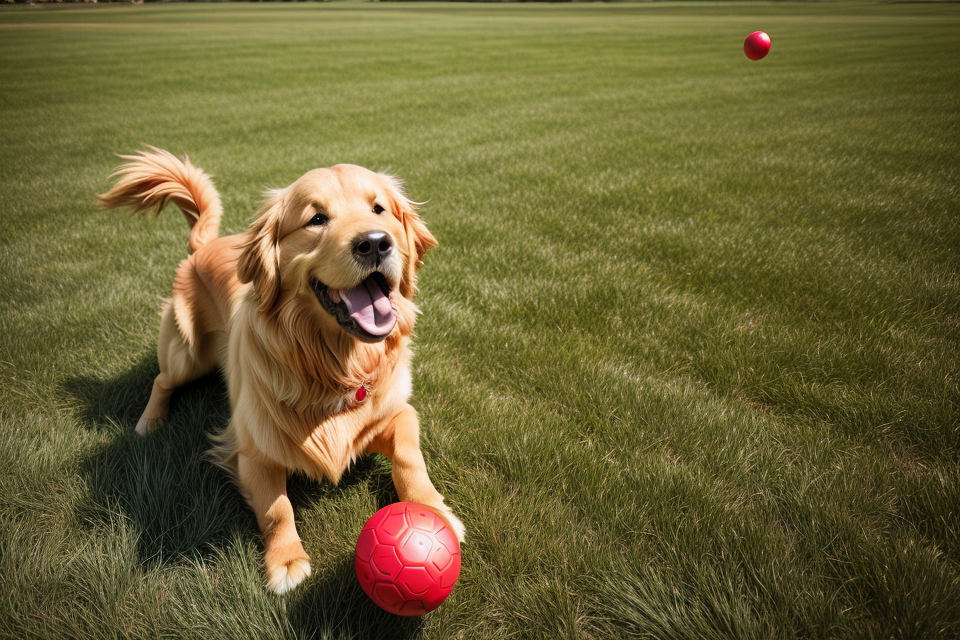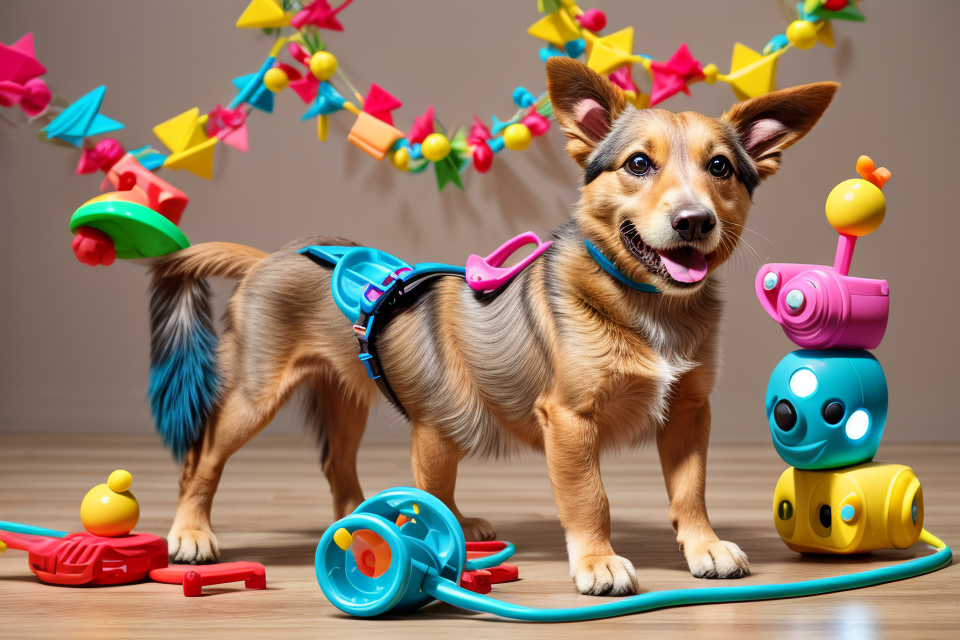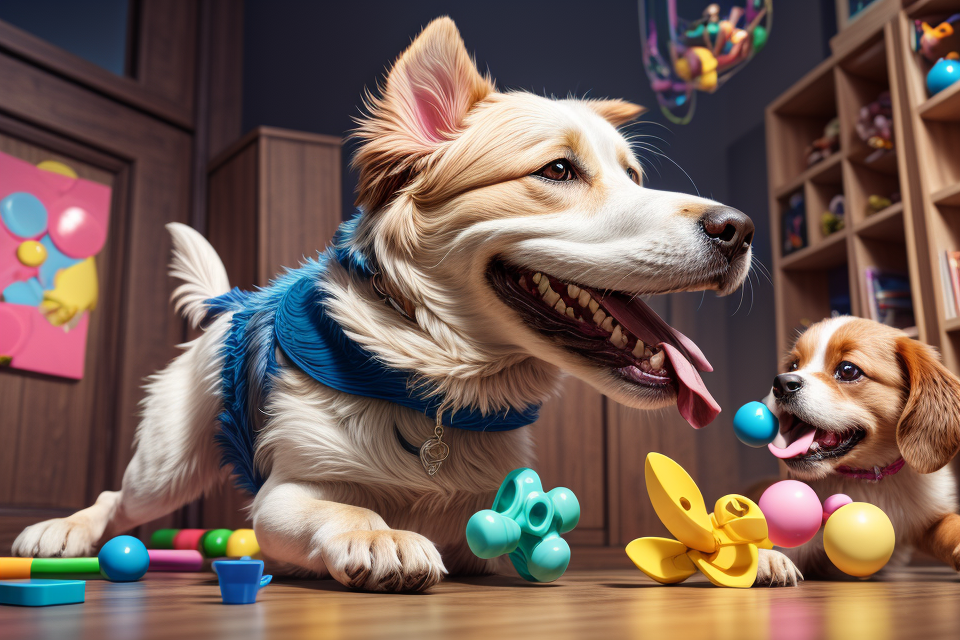As a dog owner, it’s essential to ensure that your furry friend stays mentally and physically stimulated. One of the best ways to achieve this is by encouraging your dog to play with toys. But how often should you be doing this? In this article, we’ll explore the benefits of playtime for dogs and provide guidance on how often you should be encouraging your pup to engage in this fun and essential activity. From interactive toys to solo play, we’ll cover it all, so you can ensure that your dog is happy, healthy, and entertained.
Encouraging your dog to play with toys is a great way to provide mental stimulation and physical exercise. However, the frequency of encouraging playtime with toys can depend on factors such as your dog’s age, breed, and energy level. As a general guideline, it’s recommended to provide daily opportunities for playtime and interactive games. This can help keep your dog mentally stimulated, prevent boredom, and reduce destructive behaviors. It’s also important to supervise your dog during playtime and ensure they are safe and having fun.
Benefits of Playing with Toys for Dogs
Mental Stimulation
Enhances Problem-Solving Skills
- Engaging in play with toys can enhance a dog’s problem-solving skills, as they must figure out how to manipulate and interact with the toy to obtain a desired outcome.
- Examples of problem-solving toys include puzzle toys that require the dog to figure out how to access a hidden treat or toy, and interactive toys that challenge the dog to use their sense of smell, sight, or touch to solve a puzzle.
- Providing dogs with problem-solving toys can help to keep their minds active and stimulated, which can help to prevent boredom and destructive behaviors.
Examples of Problem-Solving Toys
- Hide-and-seek toys that require the dog to use their sense of smell to find a hidden treat or toy.
- Interactive puzzle toys that challenge the dog to figure out how to access a hidden treat or toy by manipulating different parts of the toy.
- Food dispensing toys that require the dog to figure out how to get the food out of the toy by using their problem-solving skills.
Enhances Memory and Cognitive Function
- Engaging in play with toys can also enhance a dog’s memory and cognitive function, as they must remember how to solve a puzzle or where they left a toy.
- Examples of toys that can improve memory and cognitive function include scent work toys that challenge the dog to remember the location of a hidden scent, and hide-and-seek toys that challenge the dog to remember where they left a toy.
- Providing dogs with toys that challenge their memory and cognitive function can help to keep their minds active and stimulated, which can help to prevent boredom and destructive behaviors.
Examples of Toys to Improve Memory and Cognitive Function
- Scent work toys that challenge the dog to remember the location of a hidden scent, such as a treat or a toy.
- Hide-and-seek toys that challenge the dog to remember where they left a toy, such as a ball or a frisbee.
Overall, engaging in play with toys can provide numerous benefits for dogs, including physical exercise, social interaction, and mental stimulation. By providing dogs with a variety of toys that challenge them in different ways, pet owners can help to keep their furry friends happy, healthy, and engaged.
Physical Exercise
Playing with toys is an excellent way to provide physical exercise for dogs. Regular physical activity is essential for maintaining a healthy weight, building muscle, and promoting overall physical health. Toys that encourage physical activity can help meet these needs.
Keeps Dogs Active and Fit
Dogs that engage in regular physical activity are less likely to become overweight or obese, which can lead to various health problems. Playing with toys that encourage physical activity can help dogs maintain a healthy weight and improve their overall fitness level.
Examples of Toys for Physical Exercise
There are many types of toys that can provide physical exercise for dogs. Some examples include:
- Fetch Toys: Fetch toys, such as balls or frisbees, encourage dogs to run and chase after the toy. This type of activity can help build endurance and improve cardiovascular health.
- Tug Toys: Tug toys, such as ropes or toys designed for tug-of-war, can provide mental stimulation and physical exercise. They can help improve muscle tone and strength, as well as hand-eye coordination.
It is important to supervise dogs when they are playing with toys to ensure their safety and prevent any accidents or injuries. It is also essential to provide a variety of toys to keep dogs engaged and interested in playtime. By encouraging dogs to play with toys regularly, pet owners can help ensure their furry friends stay active and healthy.
Frequency of Toy Play for Different Dog Breeds and Ages
Puppies (0-6 Months)
High-Frequency Play Recommended
For puppies between 0-6 months, it is recommended to encourage toy play at a high frequency. This is because early neurological stimulation is crucial for the development of their sensory and cognitive abilities. Toy play helps to promote mental and physical growth in puppies during this critical period.
Importance of Early Neurological Stimulation
Early neurological stimulation refers to a specific set of exercises that are designed to stimulate a puppy’s senses and promote the growth of their neural connections. These exercises, which include exposure to various stimuli such as toy play, help to strengthen the puppy’s immune system, improve their cardiovascular and respiratory systems, and enhance their overall physical and mental development.
Benefits of Toy Play for Puppies
Toy play provides numerous benefits for puppies, including:
- Mental stimulation: Toy play helps to stimulate a puppy’s mind and prevent boredom, which can lead to destructive behavior.
- Physical exercise: Toy play provides puppies with the physical exercise they need to stay healthy and fit.
- Socialization: Toy play helps puppies to socialize and develop good habits, such as sharing and taking turns.
- Emotional expression: Toy play allows puppies to express their emotions and release energy in a healthy way.
Types of Toys Suitable for Puppies
There are several types of toys that are suitable for puppies, including:
- Teething Toys: These toys are designed to help puppies relieve the discomfort of teething by chewing on them.
- Soft and Floppy Toys: These toys are perfect for puppies to chew on and carry around.
- Squeaky Toys: These toys are great for stimulating a puppy’s curiosity and encouraging them to play.
Teething Toys
Teething toys are an essential part of a puppy’s toy collection. These toys are designed to help puppies relieve the discomfort of teething by chewing on them. Teething toys can be made from a variety of materials, including rubber, silicone, and nylon. They can be soft and squishy, making them perfect for puppies to chew on and carry around.
Soft and Floppy Toys
Soft and floppy toys are another popular choice for puppies. These toys are perfect for puppies to chew on and carry around. They can be made from a variety of materials, including fabric, plush, and rope. Soft and floppy toys are also great for stimulating a puppy’s curiosity and encouraging them to play.
Squeaky Toys
Squeaky toys are a popular choice for puppies. These toys are great for stimulating a puppy’s curiosity and encouraging them to play. They can be made from a variety of materials, including rubber, plastic, and fabric. Squeaky toys are also perfect for providing puppies with the mental stimulation they need to prevent boredom.
Adult Dogs
Adult dogs require mental and physical stimulation to maintain optimal health and prevent boredom. Toy play is an excellent way to provide this stimulation. Moderate-frequency play is recommended for adult dogs.
Importance of Mental and Physical Stimulation
Dogs are naturally curious and intelligent animals. Without proper mental and physical stimulation, they can become bored, anxious, or even destructive. Engaging in play with toys is an excellent way to satisfy their curiosity and intelligence while also providing physical exercise.
Benefits of Toy Play for Adult Dogs
Playing with toys has numerous benefits for adult dogs. It helps to keep their minds and bodies active, preventing boredom and promoting good health. It also strengthens the bond between the dog and the owner, as it provides an opportunity for quality interaction and fun.
Types of Toys Suitable for Adult Dogs
There are various types of toys suitable for adult dogs. Interactive puzzle toys, hide-and-seek toys, and fetch toys are some of the most popular options.
Interactive Puzzle Toys
Interactive puzzle toys are designed to challenge the dog’s problem-solving skills and intelligence. These toys can be filled with treats or peanut butter, and the dog must figure out how to get the reward. Examples of interactive puzzle toys include the Kong, Buster cube, and snuffle mat.
Hide-and-Seek Toys
Hide-and-seek toys are designed to encourage the dog to use its sense of smell and curiosity. These toys can be filled with treats or hidden with the dog’s favorite treats, and the dog must sniff them out. Examples of hide-and-seek toys include the Tug-a-Joe and the Snuffle Mat.
Fetch Toys
Fetch toys are designed for dogs that love to play fetch. These toys can be anything from a ball to a frisbee, and they provide the dog with plenty of exercise and mental stimulation. Examples of fetch toys include the Jolly Ball and the Chuckit.
In conclusion, playing with toys is an excellent way to provide mental and physical stimulation for adult dogs. It is recommended to engage in moderate-frequency play, and there are various types of toys suitable for adult dogs, including interactive puzzle toys, hide-and-seek toys, and fetch toys.
Factors to Consider When Encouraging Toy Play
Owner’s Availability and Commitment
Time Constraints
Dogs are active animals that require regular exercise and mental stimulation to stay healthy and happy. However, many dog owners lead busy lives and struggle to find the time to provide their pets with the necessary physical and mental activities.
Tips for Incorporating Toy Play into a Busy Schedule
- Start with short play sessions: If you have limited time, try to allocate a few minutes every day to engage your dog in toy play. Even a brief session can be beneficial for your dog’s physical and mental well-being.
- Incorporate toy play during walks: Take advantage of your dog’s natural curiosity by incorporating toy play during walks. For example, you can throw a toy a short distance and encourage your dog to retrieve it, or bring a new toy to each walk to keep things interesting.
- Use interactive toys: Interactive toys, such as puzzle toys and treat-dispensing toys, can provide mental stimulation for your dog even when you’re not available to supervise playtime.
Choosing Durable and Long-Lasting Toys
Dogs can be rough with their toys, and it’s important to choose toys that can withstand their playstyle. Consider investing in durable toys made from materials such as rubber, plastic, or nylon, which are less likely to break or tear easily.
Commitment to Consistency
Consistency is key when it comes to encouraging toy play in dogs. By establishing a regular routine, you can help your dog understand what to expect and look forward to playtime.
Importance of Consistent Reinforcement
Consistency helps reinforce good behavior and can help prevent destructive behaviors such as chewing or digging. By consistently providing your dog with appropriate toys and encouraging play, you can help prevent boredom and reduce the likelihood of unwanted behaviors.
Establishing a Regular Toy Play Routine
Establishing a regular toy play routine can help you and your dog form positive associations with playtime. Try to set aside a specific time each day for toy play, and make it a fun and enjoyable experience for both you and your dog. This will help create a positive association with toy play and encourage your dog to engage in play more frequently.
Rotating Toy Selection
Benefits of Rotating Toy Selection
Keeps Dogs Engaged and Interested
Dogs are naturally curious creatures, and providing them with a variety of toys can help keep them engaged and interested in playtime. Rotating toy selection can help prevent dogs from becoming bored with their toys and encourage them to continue playing.
Encourages Variety in Play
Rotating toy selection can also encourage variety in play. By providing dogs with different types of toys, such as plush toys, chew toys, and interactive toys, owners can encourage dogs to use their problem-solving skills and creativity in new ways.
Prevents Boredom and Reduces Possibility of Destructive Behavior
When dogs become bored with their toys, they may start to become destructive, chewing on furniture or other items in the home. Rotating toy selection can help prevent boredom and reduce the likelihood of destructive behavior.
Tips for Rotating Toy Selection
Set a Schedule for Rotating Toys
Owners should set a schedule for rotating toys, such as changing toys every few days or once a week. This can help dogs associate new toys with playtime and encourage them to play with the new toys.
Incorporate Different Types of Toys
Owners should incorporate different types of toys into their rotation, such as plush toys, chew toys, and interactive toys. This can help keep dogs engaged and interested in playtime and encourage them to use their problem-solving skills and creativity in new ways.
Consider Your Dog’s Favorites
Owners should also consider their dog’s favorites when rotating toy selection. If a dog has a favorite toy, it should be included in the rotation to ensure that the dog continues to enjoy playtime. However, it’s important to rotate other toys into the mix to prevent boredom and encourage variety in play.
FAQs
1. How often should dogs play with toys?
Dogs should play with toys every day. Playing with toys helps to keep dogs mentally and physically stimulated, which can help prevent boredom and destructive behavior. It’s also a great way to strengthen the bond between you and your dog.
2. How long should a dog play with a toy?
There is no set time for how long a dog should play with a toy, as every dog is different. Some dogs may enjoy playing with a toy for just a few minutes, while others may play for much longer. It’s important to monitor your dog’s behavior and make sure they are not becoming overly excited or aggressive while playing with a toy.
3. What type of toys are best for dogs?
There are many types of toys that are suitable for dogs, including plush toys, rope toys, interactive toys, and puzzle toys. It’s important to choose toys that are appropriate for your dog’s size and play style. For example, smaller dogs may enjoy plush toys, while larger dogs may prefer interactive toys that they can play tug-of-war with.
4. Can dogs play with toys too much?
While it’s important to encourage your dog to play with toys, it’s also important to make sure they are not playing too much. If your dog is becoming aggressive or destroying their toys, it may be a sign that they are playing too much. It’s important to monitor your dog’s behavior and give them breaks throughout the day to prevent over-stimulation.
5. Can I use human toys as dog toys?
It’s generally not a good idea to use human toys as dog toys, as they may not be safe for dogs. Many human toys, such as stuffed animals and dolls, have small parts that could be swallowed by a dog. It’s important to choose toys that are specifically designed for dogs and are safe for them to play with.



